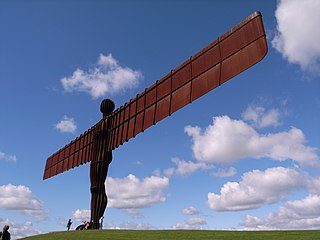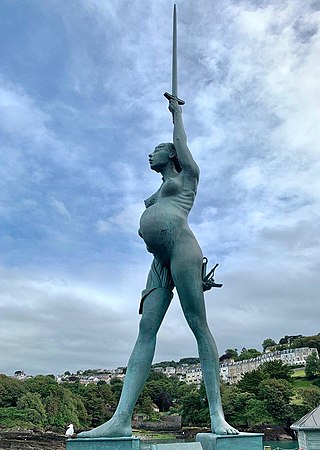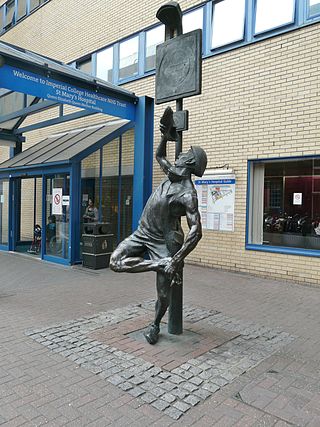Messenger, Messengers, The Messenger or The Messengers may refer to:

The Angel of the North is a contemporary sculpture by Antony Gormley, located in Gateshead, Tyne and Wear, England. Completed in 1998, it is believed to be the largest sculpture of an angel in the world and is viewed by an estimated 33 million people every year due to its proximity to the A1 and A167 roads and the East Coast Main Line. The design of the Angel, like many of Gormley's works, is based on Gormley's own body. The COR-TEN weathering steel material gives the sculpture its distinctive rusty, oxidised colour. It stands 20 metres (66 ft) tall with a wingspan of 54 metres (177 ft), larger than that of a Boeing 757 aircraft. The vertical ribs on its body and wings act as an external skeleton which direct oncoming wind to the sculpture's foundations, allowing it to withstand wind speeds of over 100 miles per hour (160 km/h).

Theatre Royal, Plymouth, is a theatre venue in Plymouth, Devon. It consists of a 1,300-seat main auditorium, The Lyric, which regularly hosts large-scale musicals, opera and ballet; a 200-seat studio, The Drum; and a 50-seat studio, The Lab. On a separate site, Theatre Royal Plymouth also has a production and learning centre, TR2, featuring rehearsal studios and workshops for the production of set and costumes.

Universal Man is a sculpture by Gerald Gladstone located outside the Yorkdale Shopping Centre in North York, Toronto, Ontario, Canada, since 1994. The 6.5-metre (21 ft) bronze figure was originally located in a prominent location at the foot of the CN Tower, there located to "emphasize the human aspects of the project". It was commissioned by CN Rail in 1972 at a cost of approximately $100,000 and the statue was unveiled in 1976. At the time of unveiling, it was the largest statue cast by the Morris Singer foundry.

The Crouching Venus is a Hellenistic model of Venus surprised at her bath. Venus crouches with her right knee close to the ground, turns her head to the right and, in most versions, reaches her right arm over to her left shoulder to cover her breasts. To judge by the number of copies that have been excavated on Roman sites in Italy and France, this variant on Venus seems to have been popular.

The ArcelorMittal Orbit is a 114.5-metre (376-foot) sculpture and observation tower in the Queen Elizabeth Olympic Park in Stratford, London. It is Britain's largest piece of public art, and is intended to be a permanent lasting legacy of London's hosting of the 2012 Summer Olympic and Paralympic Games, assisting in the post-Olympics regeneration of the Stratford area. Sited between the Olympic Stadium and the Aquatics Centre, it allows visitors to view the whole Olympic Park from two observation platforms.

The Meeting Place is a 9-metre-high (30 ft), 20-tonne (20-long-ton) bronze sculpture that stands at the south end of the upper level of St Pancras railway station. Designed by the British artist Paul Day and unveiled in 2007, it is intended to evoke the romance of travel through the depiction of a couple locked in an amorous embrace.

Two Forms (Divided Circle) (BH 477) is a bronze sculpture by Barbara Hepworth, designed in 1969. Six numbered copies were cast, plus one (0/6) retained by the sculptor. The sculpture's dimensions are 237 centimetres (93 in) by 234 centimetres (92 in) by 54 centimetres (21 in).

Verity is a 2012 stainless steel and bronze statue created by Damien Hirst. The 20.25-metre (66.4 ft) tall sculpture stands on the pier at the entrance to the harbour in Ilfracombe, Devon, looking out over the Bristol Channel towards South Wales. It has been loaned to the town for 20 years. The name of the piece refers to "truth" and Hirst describes his work as a "modern allegory of truth and justice".

The Rush of Green, also known as Pan or The Bowater House Group, was the last sculpture completed by Jacob Epstein before his death at his home in Hyde Park Gate on 19 August 1959. The sculpture group includes a long-limbed family – father, mother, son and dog – rushing towards Hyde Park, encouraged by the Greek god Pan playing his pipes. It was cast in bronze posthumously and installed in 1961 on a plinth separating the carriageways of Edinburgh Gate beneath Bowater House. The sculpture was removed when Bowater House was demolished in 2006 and reinstalled near the building which replaced it, One Hyde Park, in 2010. The sculpture was granted Grade II listed status in January 2016, giving it legal protection against unauthorised alteration or removal.

John Francis Kavanagh was an Irish sculptor and artist. In 1930 he was awarded the British School at Rome Scholarship in Sculpture.

Reclining Figure (Lincoln Center) (LH 519) is a statue by Henry Moore. The original two-part bronze statue of a human figure was commissioned for the Lincoln Center for the Performing Arts in New York City, where it has been displayed outdoors since 1965 in a pool of water to the north of the new Metropolitan Opera House. Other copies in plaster or bronze exist, and are displayed in other cities.

Allan Sly FRBS is an English sculptor and senior lecturer at Wimbledon College of Art, a constituent college of University of the Arts London.

How Doth the Little Crocodile is both a painting and an outdoor bronze sculpture by British-born Mexican surrealist artist Leonora Carrington.

The David Bowie Statue is a bronze sculpture of David Bowie sculpted by Andrew Sinclair and unveiled in 2018 in Market Square, Aylesbury, Buckinghamshire by Howard Jones.

Joseph Hillier is a British sculptor. His best known works include the Messenger, a public sculpture in Plymouth, Devon.

An equestrian statue of George Washington by Thomas Ball is installed in Boston's Public Garden, in the U.S. state of Massachusetts.

A statue of Frederick Douglass sculpted by Sidney W. Edwards, sometimes called the Frederick Douglass Monument, was installed in Rochester, New York in 1899 after it was commissioned by the African-American activist John W. Thompson. According to Visualising Slavery: Art Across the African Diaspora, it was the first statue in the United States that memorialized a specific African-American person.

The Burton Cooper is a 1977 statue by James Walter Butler currently located in Coopers Square shopping centre, Burton upon Trent. The statue commemorates the close connection of the town to the trade, which was key to Burton's brewing industry. Originally situated outdoors, the statue was relocated inside the centre when it was refurbished in 1994.

A giant puppet is a puppet which is tall enough to be easily visible to a street crowd while being manipulated by puppeteers, on the same level. It is therefore most suitable for processions, street theatre and performance art, although some large theatrical animations can be used for the same purpose. Giant puppets are usually articulated and made from a lightweight material. Some are manipulated by puppeteers using rods, strings, stilts, other mechanisms, or a combination of these. Giant puppets have been used worldwide for street entertainment, celebrations or other purposes from ancient times, and they continue in use and in development today. Of the traditional giant rod puppets, the Chinese dragon New Year puppet is "perhaps the most recognized form of the parade puppet". Of the most recent examples, Royal de Luxe of France has produced a notable set of giant string puppets.




















